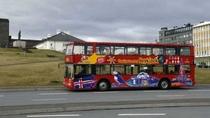2012, SEPTEMBER 1: ICELAND, REYKJAVIK - CITY TOUR
We walked about ten minutes to the nearest stop to board
the 10:35 a.m. service of the Hop On/Hop Off bus. A British couple also joined
us there. But there was no sign of bus anywhere. Disappointed the other
gentleman decided to walk to the first sight we wanted to see, a couple of
miles away close to the center of the city. His wife stayed with us.
 |
| Reykjavik Hop On/Hop Off Tour Bus |
When the bus did arrive at 11:35, the driver replied to
our queries about the 10:35 service with “I don’t know.” Also he did not know
why the taped English commentary had not been working.
Another couple who had boarded the bus at the next stop got so upset with the driver, and they walked to the bus head office and got a refund for their ticket.
Another couple who had boarded the bus at the next stop got so upset with the driver, and they walked to the bus head office and got a refund for their ticket.
We got down at the stop for the famous Reykjavik landmark,
the Hallgrimskirkja Church.
It
is a huge concrete building, and one of the tallest structures in Iceland.

Hallgrimskirkja Church, Reykjavik
In front of the church is a statue of Leif Eiricsson, who is believed to have been the first European to navigate to North America in A.D. 1000. It is said he named the new continent Vineland.
The statue was donated by the United States on the occasion of the one-thousandth anniversary of his historic trans-Atlantic voyage.

Leif Eiricsson Statue, Hallgrimskirkja Church, Reykjavik
Its interior, however, is quite plain, although
it is distinguished by the 5275 pipe organ.
Hallgrimskirkja Church Interior, Reykjavik
Pipe Organ, Hallgrimskirkja Church, Reykjavik
An hour later, we boarded the Hop On/Hop Off Bus.
Fortunately the driver was new. He was certainly more courteous than the
previous one, although his limited knowledge of English rendered him to be of little
use to the tourists.
Near the next stop and overlooking the harbor, is the
Arnarholl Hill, where, it is believed that the Ingolfur Arnarson set up the
first settlement in Reykjavik, although it took about one thousand years before
a town began to grow here.

Ingolfur Arnarson, Arnarholl Hill, Reykjavik (Open Stock Photo)
According to the oldest narrative of “The Book of Settlement,” as soon as Arnarson first sighted Iceland, he threw his high seat pillars overboard, declaring that he would settle wherever the pillars happened to be washed ashore. And it so happened that the pillars landed at the Arnarholl.
Arnarson, the first settler of Iceland, 1850 Painting by P. Raadsig (Wikipedia)
Because of steam rising up from the area’s hot springs, he
gave it the name of Reykjavik, which means “smoky bay.”
We then walked to the Culture House. It is housed in a neoclassic-style building, which was the first building, officially erected on an Icelandic initiative under home rule. Therefore, it is regarded as one of the Iceland’s national architectural monuments.
Culture House, Reykjavik
This building is in quite contrast with most of the structures in Reykjavik, which although functionally good, appear quite plain and non-descript, probably because of the strict building code due to the area’s large number of earthquakes and volcanic eruptions.
But some buildings do stand out because of their paint or some architectural elements.
Painted House, Reykjavik (As Shown in a Brochure)
Since 2000, the Culture House has served as a venue
dedicated to promote the Icelandic heritage. It has a permanent display of some
of the Iceland’s national treasures, the principal medieval manuscripts of
Icelandic sagas, as well as those depicting the medieval Northern European
society, religion, and world view.
Medieval Manuscripts, Culture House, Reykjavik
Also, at the Culture House, we saw a documentary about Leif Eiricsson’s voyage
to North America in A.D. 1000.
Nearby is the Government House, where the President
resides when he is in town. It is a rather small and unpretentious structure.
Government House, Reykjavik
An hour later we boarded the bus again for the Volcano
House, our next destination. But that was a huge mistake. It was much farther
away from our destination than the previous stop.
Fortunately, we found a young girl. Finding her English
quite limited, she decided to walk her bicycle with us to where she could point
us our way to our destination! The fact is that all the people we addressed our
questions to or asked for directions, were quite pleasant and helpful.
In a way it turned out to be a blessing in disguise.
Since it took us through one of the most scenic area of the town called, “The
Pond.” It has its own “reigning” flock of ducks. Some of the posh houses as
well as nice parks (one adorned with sculptures) surround this small lake.
Houses around The Pond, Reykjavik
Resident Ducks, The Pond, Reykjavik

It features two documentaries about Iceland’s two major
volcanic eruptions of the last 20 years.
The first one happened without any warning on the night
of January 23, 1973. It claimed about 400 houses and nearly 5, 000 people had
to flee their home and their island in matter of hours.
The other eruption took place in 2010, which disrupted
air traffic all over Europe.


Volcanic Eruptions Featured in Volcano House Documentaries
By the time we reached close to the Hop On/Hop Off stop,
it was already 4 p.m., when the bus stops operating. We decided to hire a taxi.
The close to two-mile trip cost us 1450 Icelandic Kronas, about $12.50.
We wanted to end the day with the comedy show “How to become Icelandic in 60 minutes.”
But we were too tired to venture out again in the damp and windy weather.
But we were too tired to venture out again in the damp and windy weather.











0 Comments:
Post a Comment
<< Home